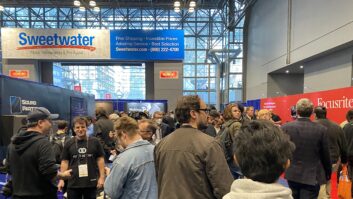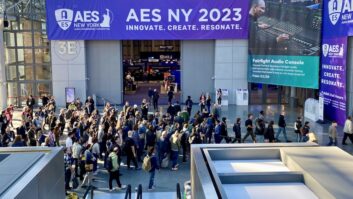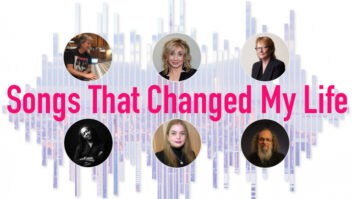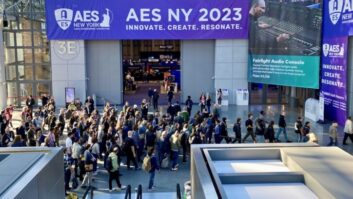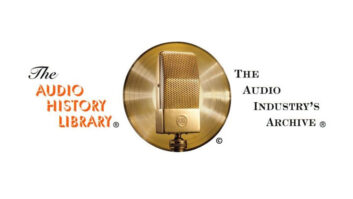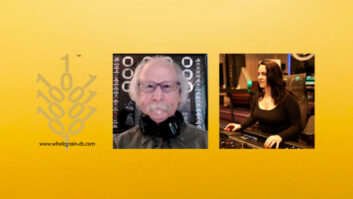FROM MAY 8 TO 11, 1999, thousands of audio professionals converged on Munich’s M.O.C. Congress Center for the 106th convention of the Audio Engineering Society. The event featured 14 workshops, 18 facility tours and 130 technical papers. Clearly there was a lot to see and hear in a four-day period, but as with previous AES conventions, all eyes were on the four exhibit halls, where more than 300 manufacturers unveiled the latest in Tontechnik.
CONSOLESThe focus was on BIG boards, with both new products and updates. Amek (www.amek.com) showed its 9098i, the in-line version of the acclaimed 9098 analog mixer, combining SuperTrue 4.0 automation with two moving faders per channel strip, bandwidth extending to 200 kHz and ranging from a 48-frame chassis to large custom ring or bucket configurations. Three mixers have already been installed, with several more in the months to come.
Amek also debuted new features for its Digital Mixing System consoles. Designed specifically for audio post, the new DMS-Post version can be reset instantly to handle any format from mono to multistem 5.1. An optional DMS-XP audio expander increases capacity to 96 mix inputs, with EQ on all channels; the optional Channel Panel control surface module offers one-control-per-function operation of all channel parameters, via 48 rotary encoder pots and 32 switches. Version 3.3 software adds simultaneous dynamic and snapshot automation, multi-user passwords/privileges, a pan/divergence editor and multiple operators mode.
Version 2.0 software for Studer’s (www.studer.ch) D950 console adds improved Virtual Surround Panning (VSP), advanced channel strip assignment and refinements that simplify console operations, along with the capability to split the desk for two-operator mixing, and new Dolby Digital EX and 7.1 surround capability. Each channel now offers variable Low Frequency Effects and center-channel feeds, as well as automatable VSP room simulator effects, with DSP-based simulations of XY/ORTF/sphere/HRTF stereo miking techniques.
Software V. 2.0 for Sony’s OXF-R3 Oxford console (www.sony.com) includes expanded multiformat functionality for 5.1 surround mixing; multiformat, multistem recording and monitoring; multiformat sub-level control from each full channel; new Sony EQ and compressor choices; jog/shuttle machine control capability; MIDI support for dynamically automating parameters of external MIDI devices and a new GUI for simpler, faster offline automation operation. The update also supports the just-announced GML signal processing option, which integrates 96 channels of GML8200 EQ and GML8900 dynamics processing.
Speaking of GML, Massenburg DesignWorks (www.gmlinc.com) is a new company founded by producer/engineer/equipment designer George Massenburg to create hardware/software tools for GML and other companies. The company’s debut product is the 2×2 High-Resolution Parametric Equalizer, a double-sample-rate plug-in. Mackie’s D8B and the Sonic Solutions Sonic Studio HD are the first products to incorporate this proprietary technology.
ESP, a new platform for AMS Neve (www.ams-neve.com) digital consoles, comprises powerful processing cards with 21 custom AMS Neve ASICs controlling nine DSP chips on a single card, which takes the load off the DSP for faster processing. Developed to provide the processing power for the company’s three-operator DFC board, ESP is a scalable, 96kHz-ready architecture that can be used with either large or compact AMS Neve consoles.
Solid State Logic (www.solid-state-logic.com) demonstrated new V4 software for its SL9000 flagship analog desk. V4 adds extended machine control, with revisions to parallel machine control and automatic ID’ing/configuration for controlling serial transports. Other enhancements include automatic file version handling, a simplified user interface, timecode masking and offsetting, while expanded grouping flexibility eases 4-channel panning with increased control of 5.1 mixes.
Several new analog boards are targeted squarely at the “pro project studio” market. Oram (www.oram.co.uk) unveiled the Oram PROject 24, a small-footprint console (frames range from 24 to 48 inputs) featuring 24-track monitoring and pricing from about $24,000. Meanwhile, Malcolm Toft (www.toft.co.uk) has begun shipping the MTA Series 924, available in 24- to 48-input versions and priced from about $12,600.
WHIPPING UP A STORMThe workstation buzz of the show was the new Soundstation Storm from DAR (www.dar.uk.com). Storm is a completely new hardware platform that puts the power of 16 of DAR’s earlier generation cards on a single card that operates five times faster and handles up to 700 MB of RAM. Initially available as a 32-track system (with the ability to simultaneously stream 32 tracks off a single hard disk), Storm is scalable up to 132 tracks and features a new high-res color touchscreen that displays up to 32 tracks at a time with selectable viewing of waveforms, visible fades/crossfades and vertical track zoom. Storm supports up to 192kHz sampling with 16- and 24-bit resolution, and has the ability to use different bit-depth segments on the same reel. Storm is available in both standard touchscreen and compact controller versions.
Based on the competitive upgrade concept so common in the computer industry, Digidesign (www.digidesign.com) made the unprecedented move of offering $1,000 toward the purchase of a Pro Tools|24, Pro Tools|24 MIX or Pro Tools|24 MIXplus system for the trade-in of an Alesis ADAT series, Tascam DA series, Sony PCM800 or Fostex RD8 MDM deck. But rather than simply attack tape-based users, the plan could provide owners of a 24- or 32-track MDM system with a more affordable means of integrating the advantages of random-access production with their tape system.
German Digidesign distributor SMM (www.protools.de) turned heads with its ProControl-Module, which takes the basic modules of a standard Digidesign ProControl controller and puts them into a large-format housing that accommodates keyboard, trackball, display monitors and the ProControl elements in a single integrated unit with everything right where you need it. The unit also offers space for adding custom accessories, such as Gallery Software’s (www.gallery.co.uk) Axis joystick surround panner or ProductionPalette 128-key edit controller.
THE HITS KEEP COMINGDesigned for large control rooms, Genelec’s (www.genelec.com) 1036A system consists of two three-way double-18 enclosures and two electronics racks with the active crossovers, 3-channel power amps, protection and diagnostic circuitry. Highs and mids are handled by two 5-inch cone drivers and a 1-inch throat compression driver, mounted on a Directivity Control Waveguide, which is rotatable for horizontal or vertical installations. The 1036As are said to produce peak SPLs in excess of 136 dB, and frequency response goes down 17.5 Hz, with a -3dB point at 19 Hz.
In other monitor news, TC Electronic (www.tcelectronic.com) has signed an exclusive agreement for the worldwide distribution of Danish studio monitor company Dynaudio Acoustics, effective June 1, 1999.
Quantec (www.quantec.de) has its eyes on regaining the reverb/effects throne with its 2402 Yardstick, which puts its classic QRS (Quantec Room Simulator) sound into a slick, single-rackspace unit priced at about $2,900. The compact unit features an extremely simple, yet powerful interface, but perhaps most interesting about the 2402 is the fact that this is the first reverb I’ve seen that has digital AES/EBU stereo I/O, but no analog connections.
NEW MIC DEVELOPMENTSMicrotech Gefell (www.microtechgefell.com) is finally shipping its KEM 970 Cardioid Plane Microphone, which has a cardioid-shaped pattern, but only in the horizontal plane. The first installation was in Germany’s new Reichstag parliament building, where the KEM 970 provides podium miking without the negative effects of reflections off the podium surface.
Sweden’s Milab (www.milabmic.com) joined the digital mic movement started by Beyerdynamic three years ago. The Milab DM-1001 is a large-diaphragm studio condenser with integral 24-bit/48kHz converter, AES and S/PDIF outputs and a software providing computer control of polar patterns and filters.
A popular attraction at AES was the DPA (www.dpamicrophones.com) 3541 large-diaphragm studio microphone, which is based on the famous B&K 4040 “gold” mic. The 3541 is available with either pentode-based or solid-state electronics, features a self noise that’s an impressive 7 dB(A) and will ship this fall.
Schoeps (www.schoeps.de) unveiled a prototype of its VariMike (variable-microphone), a remarkable stereo mic system that uses an outboard 24-bit DSP controller box and two double-transducer microphones to simulate a wide range of microphone sounds and techniques. As an example of VariMike’s versatility, knobs provide independent control of the polar pattern in three frequency ranges, offering flexibility that goes far beyond conventional mic technology. At present, VariMike is still in prototype stage, so no word on pricing or availability, but we’re keeping our eye on this one!
AES returns to New York (September 24-27, 1999), and to Paris (February 19-22, 2000). See you there!
